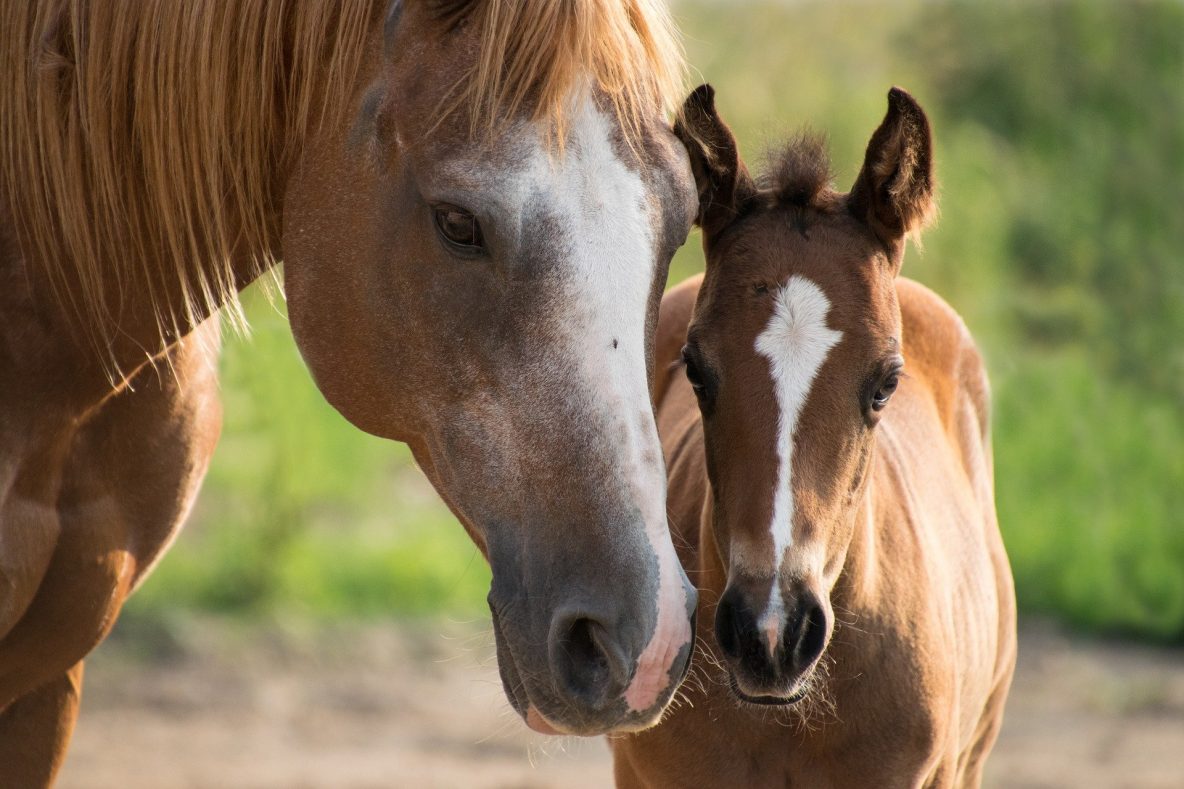NORMAL PHYSIOLOGICAL PARAMETER FOR A NEWBORN FOAL AND AN OLDER FOAL
NEWBORN FOAL
Assuming that the foaling was uneventfully, Owner should monitor the newborn foal closely for the first 24 hours. It is important to make sure that the foal shows a normal behaviour, therefore seeking for veterinary intervention at early stage if he does not.
A normal newborn foal should:
1. SITTING IN STERNAL within 5-10 minutes of birth. Foal must be considered abnormal if it lay on the floor for longer than 10 mins after birth.
2. STAND within 1 hour of birth (Pony foals generally stand within the first 30 mins of life, where larger-breed foals might take up to 2h). Foal must be considered abnormal if it takes longer than 2h to stand.
3. TIME TO SUCKLE: within 2 hours of birth. (Pony foals might take even less than that. Thoroughbred foals may take up to 3 hours).
Foal must be considered abnormal if they do not suckle within 3 hours of birth.
4. FIRST URINATION within 6 – 10 hours of birth
5. PASSING OF MECONIUM (the first feces produced by the foal, rounded in shape and very hard like “stone”) within 2 – 12 hours of birth
6. THEY SPEND MOST OF TIME SLEEPING AND SUCKLING FROM THE DAM. During the first week the foal suckle about 2 minutes, 5 – 7 times each hour. Foals that spend too long time
sleeping, gradually straggle to stand, go to the udder less often,and when they go there, they do not grab the teat, move from one teat to the udder without clutch it, therefore no actually suckling
any milk must be considered abnormal.
7. Newborn foals tend to rest in sternal recubency for the first few days. When older they will lay in lateral recumbency just like an adult horse does.
8. The normal newborn foal is often poorly coordinated and the joints and ligaments are notably slack or weak. These conformational problems may all improve dramatically over the first week of life. Whether laxity of joints tend to solve spontaneously over the first week of life with or without minimal treatment, foals that show tight joints needs to be examined at 24 hours by a vet.
9. Foals that stop suckling, develop diarrhoea, become lethargic and more and more sleepy, manifest a lameness, have a rise in temperature, do not follow the dam in the stable or outside in the paddock or have an enlarged, wet navel, require urgent attention from the vet.
Temperature Heart rate / Respiratory rate
37 – 39^C 80 – 120 bpm 30 – 35 bpm
99 – 102 ^F (beats per minute) (breath per minute)
FOALS:
A normal healthy foal should be:
1. B: bright,
2. A: alert
3. R: responsive to all external stimuli.
They should be regularly suckling from the dam and start playing with the hay/grass. They have to urinate and defecate normally.
We recommend you should know what is normal for your foal.
Temperature Heart rate / Respiratory rate
37 – 39 C 60 – 70 bpm 20– 40 bpm
99 – 102 ^F (beats per minute) (breath per minute)
1. Respiratory rate should be measured and assessed before restraint the foal if possible. Abnormally high respiratory rate with flaring nostril and big excursion of the chest would need to be examined by your veterinary
2. A digital thermometer should be used to check the rectal temperature and should be pressed gently against the rectal mucosa.
3. Foal should gradually and regularly put weight on. The foal should develop fat and muscle day by day.
4. Normal foals are usually mildly resentful of restraint and appear to be ‘rather nervous’. They should follow the dam, explore the surrounding environment and suckle regularly and often. Foals that become depressed, dull required veterinary attention.
5. The umbilicus should be examined carefully and frequently. Any detectable swelling or abnormal thickening or heat should lead to a detailed examination by you vet. Foal can develop an umbilical infection up to 6 – 8 weeks of age. Also, umbilical and inguinal hernia required attention. The normal umbilicus of the foal is wet for the first 24 hours, then becomes progressively drier and shrivels considerably. A dry stump falls off naturally between 2- 4 weeks.
6. The urachus it is another important anatomical structure in foals. It is the conduit for urine passage into the allantoic cavity during gestation and it normally close at the time of parturition. If it suddenly becomes wet again or urine can be detected coming out from the stump while the foal is urinating, the foal needs to be examined by the vet.
7. Lameness may be difficult to identify because foals are often mildly uncoordinated. Swollen, hot or painful joints must be explored immediately.
8. Any deviation of the legs, whether is angular (to one side) or flexural (“too soft or too tight”) would need to be examined.
9. Please see the “worming” and “ vaccination” articles for recommendations on those two topics.
Foal Care
In the first month, foals should have access to turn out for at least 12 hours a day but they should not have
any forced exercise for fear of any damage to the growth plates which can can contribute to angular limb deformities.
Young foals will sleep …
They should be nursing from their mother up to 3 of 4 times an hour.
If you notice that your foal is nursing for longer periods (up to half an hour total time in an hour) it may be the mother does not have enough milk. The foal may require some supplementation and the dam may require a better diet.
Your foal may start taking interest its mothers’ food and in her her droppings. This helps establish a flora in the foal’s intestine, so he can better digest the feed he will soon begin eating.
When your farrier comes to trim your mare’s feet, have him examine the foal’s feet as well. In addition to
having your foal become accustomed to having its feet handled, the farrier can often identify early limb
deformities which can be corrected by trimming or rasping. Please consider planning this with us if your foal begins
developing an angular limb deformity (toeing in, toeing out) at this early stage as some these problems are
easily addressed sooner rather than later.
Month 2
Your foal will require worming. The targeted parasites large round worms. A good first time deworming product is one that contains fenbendazole. We can help you with dosing appropriately by weight if you are unsure how much your foal weighs. Foals can be introduced to first feeds as well. Important that at this stage your foal does not consume more that 0.75-
1.0 lbs of feed per 100lbs of body weight a day as high energy feeds in a young rapidly growing foal can
contribute to growth abnormalities such as inflammation of the growth plates and contracted tendons.
Foals will also start nibbling at their mother’s hay and will start grazing, they still get the majority of their nutrients from the mother.
Month 3
In this month we can administer the first set of vaccinations, if the mother was not vaccinated shortly before
the foal was born.
At this age, your foal will be even more active and will be growing rapidly, consuming more solid feed yet still requiring nutrients from mothers milk.
Month 4
If necessary, it is possible to wean your foal now although it would still benefit nutritionally from its dam. It is also still learning behaviour from mum.
It should be wormed with product containing fenbendazole.
Month 5 onwards
Any time from 5 – 6 months you can prepare for weaning.
Your foal should be vaccinated 2-4 weeks before weaning. We can advise regarding timings and consider whether you plan on travelling and showing your foal as a
youngster where it may have exposure to these pathogens.
In order to prepare for weaning it is prudent to try separating from mother for short periods of time, this to accustom both the mare and foal.
Your foal should be getting the majority of his nutrition from his feed and not from his mother and many mares begin drying up at this pre-weaning stage.
Prior to weaning, we can support with a fecal egg count and determine how your our next wormer should be targeted.
Your foal should be eating 1 pound per hundred pounds of body weight of a good quality concentrate once a day, and be eating a high quality hay. Low stress weaning should be encouraged in order to minimize stress. This can be done by first keeping mother and foal in separate stalls beside one another with individual turn out then gradually increasing their distance apart.

